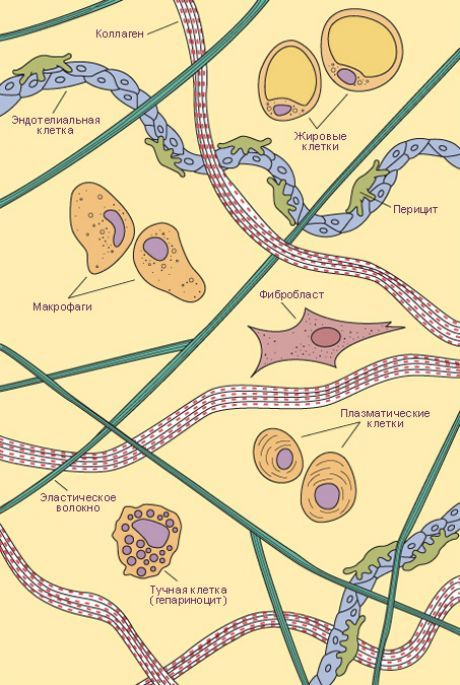
All iLive content is medically reviewed or fact checked to ensure as much factual accuracy as possible.
We have strict sourcing guidelines and only link to reputable media sites, academic research institutions and, whenever possible, medically peer reviewed studies. Note that the numbers in parentheses ([1], [2], etc.) are clickable links to these studies.
If you feel that any of our content is inaccurate, out-of-date, or otherwise questionable, please select it and press Ctrl + Enter.
Connective tissue
Medical expert of the article
Last reviewed: 04.07.2025

Connective tissue (textus connectivus) is a large group of tissues, including connective tissues proper (loose and dense fibrous), tissues with special properties (reticular, adipose), liquid (blood) and skeletal (bone and cartilage). These tissues perform many functions: supporting, mechanical (connective tissues proper, cartilage, bone), trophic (nutritional), protective (phagocytosis and transport of immunocompetent cells and antibodies). Connective tissues are formed from numerous cells and intercellular substance, consisting of proteoglycans and glycoproteins (adhesive proteins), as well as various fibers (collagen, elastic, reticular).
All types of connective tissue are derivatives of mesenchyme, which, in turn, is formed from the mesoderm

Connective tissue cells
Fibroblasts are the main cells of connective tissue. They are spindle-shaped, with thin short and long processes extending from the surface of fibroblasts. The number of fibroblasts in different types of connective tissue varies, and they are especially numerous in loose fibrous connective tissue. Fibroblasts have an oval nucleus filled with small chromatin lumps, a clearly distinguishable nucleolus, and basophilic cytoplasm containing many free and attached ribosomes.
 [ 3 ]
[ 3 ]
Fibrous connective tissues
Fibrous connective tissues include loose and dense fibrous connective tissues. Dense fibrous connective tissue, in turn, has two varieties - unformed and formed dense connective tissue.
Fabrics with special properties
Connective tissues with special properties include fatty, reticular and mucous tissues. They are located only in certain organs and areas of the body and are characterized by special structural features and unique functions.
Fabrics with special properties
Blood
Blood is a type of connective tissue. Its intercellular substance is liquid - it is blood plasma. The blood plasma contains ("float") its cellular elements: erythrocytes, leukocytes, and thrombocytes (platelets). A person weighing 70 kg has an average of 5.0-5.5 liters of blood (this is 5-9% of the total body weight). The functions of blood are to transport oxygen and nutrients to organs and tissues and remove metabolic products from them.
Blood plasma is the liquid remaining after the formed elements - cells - have been removed from it. It contains 90-93% water, 7-8% various protein substances (albumins, globulins, lipoproteins, fibrinogen), 0.9% salts, 0.1% glucose. Blood plasma also contains enzymes, hormones, vitamins and other substances necessary for the body. Plasma proteins participate in the blood clotting process, ensure the constancy of its reaction (pH 7.36), vascular pressure, blood viscosity, and prevent the sedimentation of erythrocytes. Blood plasma contains immunoglobulins (antibodies) that participate in the body's defense reactions.
The glucose content in the blood of a healthy person is 80-120 mg% (4.44-6.66 mmol/l). A sharp decrease in the amount of glucose (to 2.22 mmol/l) leads to a sharp increase in the excitability of brain cells. A further decrease in the glucose content in the blood leads to impaired breathing, blood circulation, consciousness and can be fatal for a person.
Использованная литература

